Introduction
Monument Valley is a puzzle game developed by Ustwo Games available on Android, iOS, Microsoft Windows, and Windows iPhone. Due to the game’s beauty and simplicity, it is meant for anyone of any age who enjoys solving aesthetically pleasing puzzles and the satisfaction that comes from it. The game’s narrative centers around Princess Ida, who must journey through complex, seemingly impossible mazes. Two core mechanics dominate the game: moving around the map, and manipulating movable objects to create walkable paths.
Central Argument
Puzzles in Monument Valley arise due to Princess Ida being presented with seemingly impossible mazes that require out-of-the-box thinking and otherworldly geometry to solve. Besides walking around the maze, most of Monument Valley‘s mechanics come from solving these puzzles, which revolve around manipulating the geometry of each maze. Perfectly simple yet complex in nature, the mechanics behind the unearthly puzzles in Monument Valley foster an immersive, interactive experience for players, cultivating discovery, wonder, and out-of-the-box thinking.
Analysis
Monument Valley consists of 10 distinctly-themed levels, each presenting players with a unique challenge: navigating through a seemingly impossible maze. The game’s central mechanic of manipulating perspective and geometry creates puzzles that defy conventional logic, encouraging players to think outside the box. For example, in Level 2, Princess Ida faces a bridge that leads nowhere at first glance. However, once the player realizes that the bridge can be rotated, they are able to create a viable path for Princess Ida to take (Figures 1-3). Unlike traditional puzzle games where solutions often rely on predictable patterns or earthly logic, Monument Valley‘s puzzles require players to grapple with unconventional thinking in order to journey through the surreal game world.

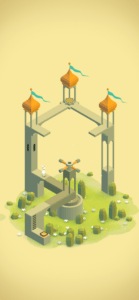
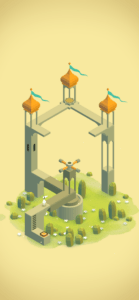
In contrast to other puzzle games like The Room which focus on logical problem-solving within realistic environments, Monument Valley takes on a more creative and liberal approach. By introducing otherworldly geometry and abstract landscapes, Monument Valley encourages players to explore and discover new avenues of problem-solving, cultivating not only out-of-the-box thinking but out-of-the-world thinking in the process. As pictured below, during Level 9, there was one instance where it was physically impossible (on Earth) to go from one floor to the next. It was only through a clever, unearthly manipulation of depth perception that I was able to go from Point A to Point B (Figures 4-6).
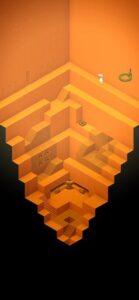
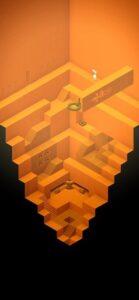
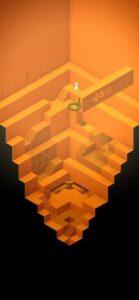
Because the game necessitates the use of law-defying geometry to solve the puzzles of each maze, players’ preconceived notions of space and depth are completely upended and challenged. This invites and paves the way for moments of revelation and discovery as players uncover hidden pathways and solutions. The game developers’ avant-garde design emphasizes exploration and experimentation, fostering a sense of wonder and discovery as players delve deeper into the mysteries of each maze.
On top of the captivating puzzles found in Monument Valley, throughout the game (typically at the end of each level), players are revealed bits of the backstory surrounding Princess Ida and why she’s embarking through a geometrically nonsensical world (Figures 7-8). By strategically placing these bits of narrative at the end of each level, not only are the game designers providing further motivation for players to solve each level, but they’re also employing a mix of loops and arcs in their game architecture to create a more holistic, well-rounded experience for the players. Through this so-called “cutscene-gameplay-cutscene” sandwich, the game designers are able to foster an emotional connection between the player and the game. If the game designers had opted solely for puzzles devoid of any backstory, while the puzzles’ challenge would undoubtedly captivate players, the overall engagement and immersion in the game would lack the depth and emotional resonance cultivated by the inclusion of narrative elements.


Conclusion
To conclude, Monument Valley is unlike any game I’ve played due to its unmatched beauty and elegance. From its beautiful soundtrack, simplicity in mechanics, breathtaking art, intricate design of mazes, and subtle narrative, Monument Valley is in a league of its own in my list of puzzle games. If I had to be really picky, one critique I have is that players can finish the entire game in a matter of hours. By potentially adding more levels or increasing the difficulty of the puzzles, the game could potentially make more players satisfied.


